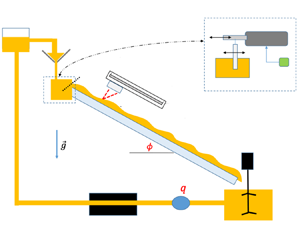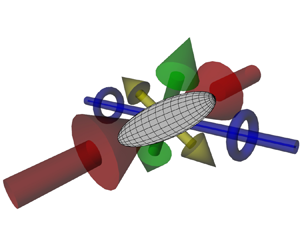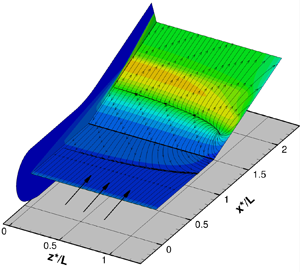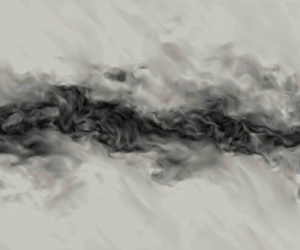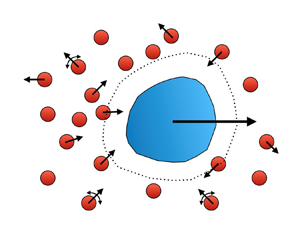Graphical abstract from Bussonnière, A. & Cantat, I. 2021 Local origin of the visco-elasticity of a millimetric elementary foam. J. Fluid Mech. 922, A25. doi:10.1017/jfm.2021.529.
Photo Credit: Courtesy of Adrien Bussonnière and Agathe L'Hermet.
Obituary
PROFESSOR CHARLES ROGERS DOERING 7 January 1956–15 May 2021
-
- Published online by Cambridge University Press:
- 21 July 2021, E1
-
- Article
-
- You have access
- HTML
- Export citation
JFM Rapids
Bounds for internally heated convection with fixed boundary heat flux
-
- Published online by Cambridge University Press:
- 05 July 2021, R1
-
- Article
- Export citation
Primary instability of a visco-plastic film down an inclined plane: experimental study
-
- Published online by Cambridge University Press:
- 07 July 2021, R2
-
- Article
- Export citation
Experimental evidence of vortex-induced vibrations at subcritical Reynolds numbers
-
- Published online by Cambridge University Press:
- 09 July 2021, R3
-
- Article
- Export citation
Convective, absolute and global azimuthal magnetorotational instabilities
-
- Published online by Cambridge University Press:
- 12 July 2021, R4
-
- Article
-
- You have access
- Open access
- HTML
- Export citation
Optimal swimmers can be pullers, pushers or neutral depending on the shape
-
- Published online by Cambridge University Press:
- 12 July 2021, R5
-
- Article
-
- You have access
- Open access
- HTML
- Export citation
Shape- and scale-dependent coupling between spheroids and velocity gradients in turbulence
-
- Published online by Cambridge University Press:
- 13 July 2021, R6
-
- Article
-
- You have access
- Open access
- HTML
- Export citation
Focus on Fluids
Exotic wakes of an oscillating circular cylinder: how singles pair up
-
- Published online by Cambridge University Press:
- 06 July 2021, F1
-
- Article
-
- You have access
- HTML
- Export citation
JFM Papers
Wall temperature and bluntness effects on hypersonic laminar separation at a compression corner
-
- Published online by Cambridge University Press:
- 02 July 2021, A1
-
- Article
- Export citation
Bursting bubble in a viscoplastic medium
-
- Published online by Cambridge University Press:
- 05 July 2021, A2
-
- Article
-
- You have access
- Open access
- HTML
- Export citation
On the role of vorticity stretching and strain self-amplification in the turbulence energy cascade
-
- Published online by Cambridge University Press:
- 02 July 2021, A3
-
- Article
- Export citation
Stokes–Darcy system, small-Darcy-number behaviour and related interfacial conditions
-
- Published online by Cambridge University Press:
- 02 July 2021, A4
-
- Article
-
- You have access
- Open access
- HTML
- Export citation
Direct numerical simulations of temporal compressible mixing layers in a Bethe–Zel'dovich–Thompson dense gas: influence of the convective Mach number
-
- Published online by Cambridge University Press:
- 02 July 2021, A5
-
- Article
- Export citation
Direct numerical simulations of transient turbulent jets: vortex-interface interactions
-
- Published online by Cambridge University Press:
- 02 July 2021, A6
-
- Article
- Export citation
Two-phase gravity currents in layered porous media
-
- Published online by Cambridge University Press:
- 02 July 2021, A7
-
- Article
-
- You have access
- Open access
- HTML
- Export citation
Direct numerical simulation of a supercritical hydrothermal flame in a turbulent jet
-
- Published online by Cambridge University Press:
- 09 July 2021, A8
-
- Article
- Export citation
Near-wall turbulence modulation by small inertial particles
-
- Published online by Cambridge University Press:
- 05 July 2021, A9
-
- Article
- Export citation
Phoretic motion in active matter
-
- Published online by Cambridge University Press:
- 05 July 2021, A10
-
- Article
- Export citation
Barotropic instability of a time-dependent parallel flow
-
- Published online by Cambridge University Press:
- 05 July 2021, A11
-
- Article
- Export citation
Stabilization of purely elastic instabilities in cross-slot geometries
-
- Published online by Cambridge University Press:
- 07 July 2021, A12
-
- Article
-
- You have access
- Open access
- HTML
- Export citation















